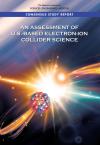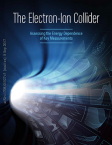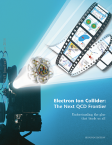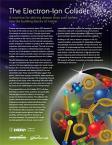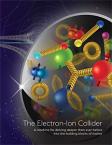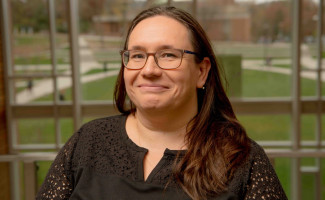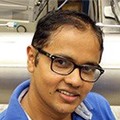New JLUO Chair Has Active Program, Long Leadership History at Jefferson Lab
Julie Roche, the 2018-2019 Jefferson Lab Users Organization (JLUO) chair, wants to know how subatomic matter organizes itself, what phenomena emerge from that organization and whether or not scientists fully understand the fundamental interactions that are basic to the structure of matter.
In pursuit of answers, Roche came to work at the lab in 1997. A native of Clermont-Ferrand, France, Roche had been a doctoral student studying in Paris when she first heard about the new Continuous Electron Beam Accelerator Facility (CEBAF). In 1999, she eagerly applied for and was hired for a postdoctoral position at the lab—a position that she held for six years.
“I came to the U.S. specifically to work at Jefferson Lab,” she says. “The lab was just starting, and it was the future of the field. It sounded exciting.”
Now, 20 years later, Roche and a board of 13 members lead the JLUO—a collection of 1,500 scientists and researchers from more than 200 institutions and 36 countries who use the lab. “I still feel that the lab is the future of the field,” she says.
Active Physics Program
From her home at Ohio University, Roche returns to the lab every few weeks to continue her research, which has been continuously funded through grants from the National Science Foundation since 2007 (through four competitive proposal cycles). “Because of the size of the collaboration and because I am a spokesperson, I am involved at the leadership level in all aspects of the experiment: proposing, advocating, preparing the hardware, taking data, analyzing and publishing,” she wrote in her ‘Statement on Nature and Significant Scholarship for Ohio University.
“The goal of my current research is to produce a 3-D tomographic picture of the internal structure of the proton against which models of the Strong force can be tested,” wrote Roche. “We simultaneously map out the momentum and spatial distribution of the quarks inside the proton. The ideas that make these studies possible are new (less than 20 years), and my collaborators and I are leaders in the exploration of the limit of validity of these ideas. To do so, our experiments measure of the absolute probability of the Deeply Virtual Compton Scattering (aka DVCS) process. In this process, an electron strikes a proton, which in turn emits a photon before recoiling undisturbed (ep → epγ).”
Leadership and Advocacy
To that end, Roche is the spokesperson for three experiments at the lab: E07-007, E12-06-114 and E12-13-010. Roche works on these experiments with about a dozen core collaborators. Experiment E12-06-114 was one of the first experiments to be done with the CEBAF upgrade, which doubled the machine’s maximum energy from the previous iteration. “I was lucky enough to be one of the first to use the new machine,” says Roche. “We studied the internal structure of protons and neutrons which are made up of quarks.”
To work on experiment E12-06-114, Roche took an 18-month sabbatical from Ohio University and relocated to Newport News. Roche and her team of collaborators, two graduate students and two undergraduate summer interns worked in shifts around-the-clock to maximize their efficiency and ensure that they got the maximum use from their time with the CEBAF.
Roche has published a total of 77 papers in peer-reviewed journals and has been cited nearly 4,000 times.
“It can take up to seven years to get access to CEBAF once your experiment is accepted,” says Roche. “It’s expensive to have the beam available. It’s also very competitive to get the beam allocated for your experiment. You get it for a set number of days and at the end of those days, you have to be done. You’re not coming back, because so many people are waiting.”
Through her new role, Roche plans to advocate for more funding to keep the facility running at greater capacity. “We have already proposed enough experiments to keep the CEBAF running at full operation for about a decade,” she says.
Roche already has a long history of leadership and advocacy at the lab. From 2004 to 2006, she represented the postdoctoral fellows on the board of directors of the Users Group and from 2007 to 2008, she was the chair of the Hall C steering committee as well as the Hall A Collaboration Committee.
Training Next Generation
When she is not physically at the lab, Roche takes her work home to Ohio and continues to mull it over alongside her physicist husband, who she met at the lab in 2001.
Roche’s passion for physics is made greater through her work at the university, which she says inspires her to think about physics from different perspectives. “When I’m not working at the lab, I’m working at the university,” she says. “I like teaching. I like thinking about what is important about physics.”
Through her role as JLUO chair, Roche also looks forward to sharing the importance of the discoveries made at the lab and promoting training for the next generation of scientific workers.
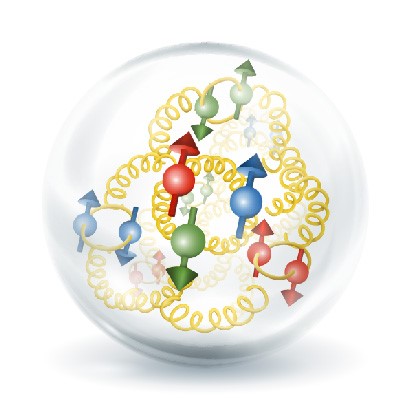 At the heart of the atom are protons and neutrons. The characteristics and interactions of neutrons and protons, singly and collectively in the nuclei are responsible for how our cosmos developed and how our sun provides the heat that sustains the eco-system on earth.
At the heart of the atom are protons and neutrons. The characteristics and interactions of neutrons and protons, singly and collectively in the nuclei are responsible for how our cosmos developed and how our sun provides the heat that sustains the eco-system on earth. 






